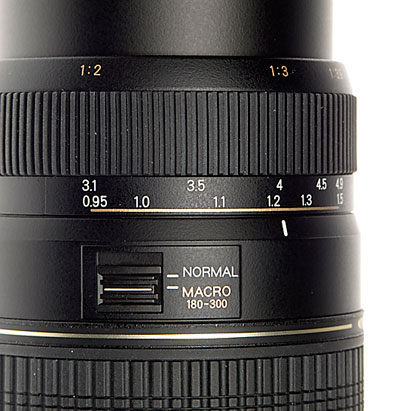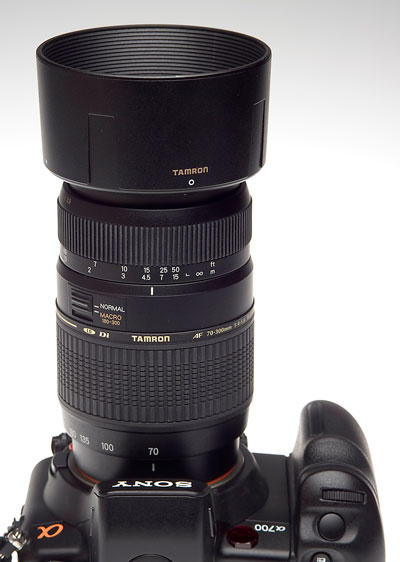Tamron 10-24mm ƒ3.5-4.5 announced
TAMRON has announced that its new 10-24mm lens will be an ƒ3.5-4.5 design – not an ƒ2.8 as some rumours had it – and will hit the shops in Nikon and Canon mounts first, on September 20th.
Cameracraft magazine – Taking your practical photography further

TAMRON has announced that its new 10-24mm lens will be an ƒ3.5-4.5 design – not an ƒ2.8 as some rumours had it – and will hit the shops in Nikon and Canon mounts first, on September 20th.
Our cover photo for the Spring 2008 issue of Photoworld was taken with a Tamron 70-300mm zoom costing less than £120 from most larger retailers or internet shops. The reputation of the lens meant we had to take a look at it, because the current choice in the Sony range is limited to one ‘kit’ 75-300mm costing £179, and the new 70-300mm G SSM lens costing £600.
The Minolta 100-300mm f/4.5-5.6 APO (D) was one of the well-respected lenses not continued into the Sony line, possibly because it is thought to be a model designed for Minolta by Tokina just as the 100-400mm was. Sony part-owns Tamron, and Tokina is part of Hoya which now owns Pentax. Though all the lens makers source components and special types of glass from each other, the facilities which built the 100-300mm may not have been available when Sony took over.
The big question is why Sony did not opt for the 70-300mm f/4-5.6 Tamron Di lens instead of continuing the lower aperture 75-300mm. It would presumably have sold for about the same price in Sony guise.

The Tamron is a fairly unique design. It has a separate macro range, accessed by pushing a switch when you are between 180mm and 300mm zoom, and at minimum focus. You can not engage the macro range until you have these conditions met. Once you are in macro mode, the zoom is limited from 180-300mm, but the entire focus range is enabled from 0.95m to infinity with autofocus. It is a slow focusing lens and like other Tamrons with low gearing to drive the AF, appears to be very accurate on all the Dynax bodies.

This lens is of course suitable for film bodies, and unlike the new 70-300mm G SSM, it will work on models like the Dynax 9 unmodified, Dynax 800si, 7xi, 7000 and so on. Many owners have functioning film bodies of an older date and the move to SSM locks these out of AF functionality with all bodies prior to the 1999 Dynax 7.

This is a full aperture image detail – the bright reflected spots show how the aberrations surround or flare out from a sharp core image, which contains very fine detail – Alpha 350 original in-camera JPEG clip
The lens uses LD (Low Dispersion) elements, but it is not apochromatic and at full aperture displays some visible aberrations especially surrounding sharply focused light details. The image ‘core’ remains very crisp behind this veil of secondary imaging, and it only takes a little stopping down to tidy up the results. Our Bengal tiger cub (one of triplets born in the crocodile animal rescue park near Ingenio, Gran Canaria) was caught in movement, at full aperture, and despite the overlay of softness you can pick out eyelash-level detail on the 14.2 megapixel Alpha 350 image.

Here is the very next shot on the card – a 100 per cent clip of a zero sharpening, no NR, no processing ACR raw conversion from a shot taken fairly close to an alligator, f/9 and 130mm. The lack of colour fringes on the bright highlights is impressive.
Please remember what a 100 per cent clip from a non-sharpened 14 megapixel file actually is. Yes, I can make a 600 x 400 web image which looks sharper than this but making a 4952 x 3056 image at this sharpness with any USM – a five foot wide overall image at normal screen resolution – really tests any lens.
Zoom and apertures
You may have been reading the last article about kit zooms and note the graph showing that with cheaper lenses the aperture is likely to be cut early on in the zoom range. You might assume that £120-worth of Tamron would prove no different. You would be wrong, and this is one of the unique aspects of the lens.
The Tamron holds its maximum f/4 all the way from 70mm to 135mm, making it a full stop faster in this range than, for example, the 16-105mm SAL. It takes the same filter size and despite extending to 300mm, uses a single barrel tube and weighs only 435g. The aperture drops to f/4.5 between 135mm and 210mm. Even this is impressive; it’s as fast as the CZ 16-80mm at 80mm, all the way to 210mm.

Finally, at 210mm it does get cut to ƒ5 and it only becomes f/5.6 in the last 20mm of focal length, between 280mm and 300mm. The SAL 75-300mm becomes f/5 at 90mm andf/5.6 at just 125mm – the penalty for squeezing into a 55mm filter thread.
Even the SAL 70-300mm SSM G series lens is only f/4.5 from 70 to a mere 85mm, from then on it is f/5, and at 135mm it drops to f/5.6 all the way to 300mm. The Tamron is 2/3rds of a stop faster throughout most of its range on paper. In practice, we found that either f/5.6 on the Sony SSM is as fast as f/5 on the Tamron (due to coatings), or the Tamron is more optimistic in reporting its apertures!
Minimum focus
The Tamron 70-300mm manages a repro ratio of 1:2 – half life size on the sensor. That means a subject just 2″/50mm wide fills the entire frame (3″/75mm wide for full frame or film cameras). In Sony’s terminology, that is a 0.50X magnification at closest focus and 300mm setting. If you shoot macro on film right now, buying a digital body and this lens would give you the equivalent of your 1:1.5 mark on your macro lens.
No Sony or recent Minolta/KM zoom whether standard, tele or superzoom range offers better than 0.29X. It also stops down to a rather staggering f/45 at 300mm, not advised as sharpness suffers but potentially useful for macro work.
A comparison
We found the 70-300mm to be a fair match for our discontinued 100-300mm APO (D) overall. wider in aperture, and much better for small subjects. The 100-300mm’s repro ratio is just 0.25X, at 1.5m. It is f/4.5 as early as 120mm and f/5.6 from 150mm to 300mm.

Both lenses have solid metal mounts; both have eight contacts for full D specification; the 100-300mm doesn’t go down to 70mm, and it weighs 50g more.
The Tamron can be recommended as a bargain performer all round, ideal for anyone on a budget wanting a travel and general tele zoom with a very fast maximum aperture compared to other offerings.
– David Kilpatrick